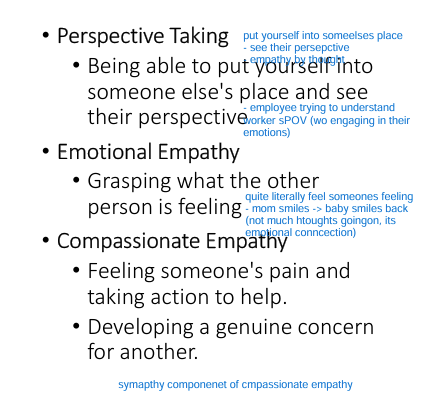3. empathy more (all done PP)
1/10
There's no tags or description
Looks like no tags are added yet.
Name | Mastery | Learn | Test | Matching | Spaced |
|---|
No study sessions yet.
11 Terms
What is empathy?
to put oneself into another’s shoes
-recreate another persons perspective
-experience the world form their POV
(seeing from their pov)
“walking a mile in another persons shoes”
(LO1) What are the different levels of empathy?
1) perspective taking
-put yourself into someone elses shoes
-employer trying to understand workers POV
2) emotional empathy
-literally feeling what they’re feeling
-ex. mom smiles; baby smiles back (not much though going on; emotional connection)
3) Compassionate empathy
-sympathy component? (the fuk)
-feeling someones pain & taking action to help
- developing genuine concern

(LO2) How can we distinguish b/w EMPATHY & SYMPATHY?
E = clearly imaging whats its like to be in the others position
- neither agreement or disagreement
- no judgment
- “what led you to that hurt”
S = involves JUDGEMENT
- agreeing w/ others reaction
- “im sorry you’re hurt”
Benefits of empathy
-stronger relationships
-increased communciation
-better conflict resolution
Cons of empathy
-emotional burnout
-vulnerability
-emotionally exhausting
-vicarious trauma = traumatized from other ppls experiences
empathy's’ benefits to patients
1) more udnerstood
Less:
2) anxious
3) alienated
4) angry
5) depressed

empathy’s benefits to YOU
1) good relationship w/ coworkers
2) better work enviornemnt
3) increased social competence
organization - social - individual
Those higher on persepctive taking tend to experience LESS distress when witnessing neg experience. Why?

What are paraphrases?
helps check you assumptions
(LO1) What are the different types of paraphrasing
1) informational = summarize content (not underlying meaning)
- verify instructions/details
2) empathetic = underlying meaning
- show you’re listening
- deepends relationship
slide 20-33 = practice